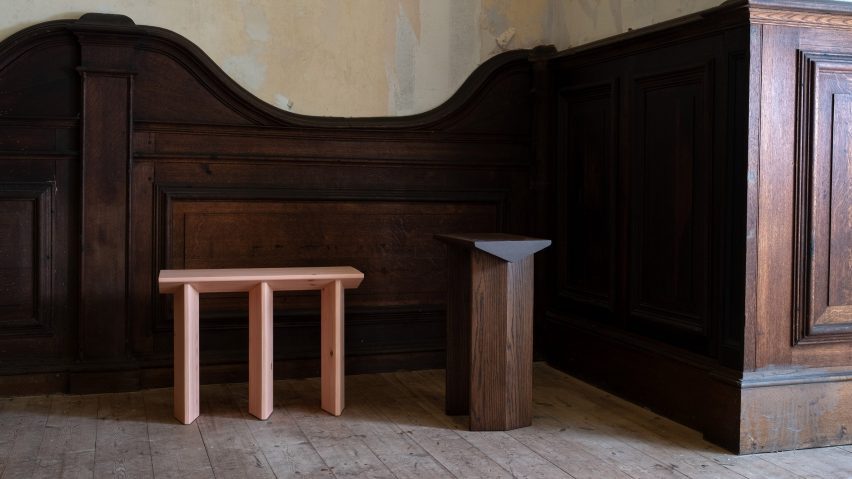Tutors and researchers from Northumbria University have filled a derelict manor house, nestled in a curve of the River Coquet in Northumberland, with objects informed by the site's rich history and materiality.
The exhibition titled Material & Memory is being held at Brinkburn Priory and Manor, a former 12th-century monastery that fell into ruin and was restored in the 19th century, when the manor house was built alongside it.
Around 20 faculty members and researchers from Northumbria University's School of Design and Department of Architecture created works that reference the fabric and atmosphere of the historic buildings.
Co-curator and assistant design professor Anthony Forsyth said the pieces created for the show were influenced by the "tranquil and atmospheric" spaces at Brinkburn, as well as by the multiple layers of history evident in the empty rooms.
"The raw materiality of the spaces is a rich source of inspiration, while the span of history informs an approach that is contemporary yet acknowledges the past," he explained.
Several contributions reference architectural features that were exposed as part of English Heritage's efforts to stop dry rot from destroying the manor, which had fallen into disrepair before the preservation charity took over responsibility for the house in 1965.
Forsyth's Mullion plinths feature forms derived from the tapered profile of the building's stone window mullions, while the Nook candleholders created by design lecturer Joshua South replicate the form of a shouldered door arch in patinated sand-cast bronze.
In collaboration with woodworker Johnny Hayes, South also developed the Quatrefoil tables, which are based on a pattern of overlapping circles commonly featured in medieval emblems and found in the stained-glass windows of the Priory at Brinkburn.
Philip Luscombe, who teaches on the university's Furniture and Product course, created a lamp with an oak structure that evokes the robust construction of church furniture.
The Monk lamp's paper diffuser references religious texts and creates a warm glow when the light is turned on.
Forsyth also developed the Assemblage floor lamp, constructed using off-the-shelf components and parts retained from other projects.
The design is informed by the state of the interior at Brinkburn, where layers of construction have been exposed and the reuse of materials is evident.
Ben Couture, assistant architecture professor and co-curator of the exhibition, created a geometric yellow bench that intentionally contrasts with the architectural style of the manor house.
The bench responds to the dimensions of the adjacent windows, through which visitors can look out towards the river.
The exhibition includes various other works in mixed media, ranging from etchings to printed textiles, photomontages and wallpapers. Each of the pieces was created following repeated visits to the site and through conversations with experts at English Heritage.
The charity previously worked with Northumbria University on a similar exhibition of objects displayed at Aydon Castle, also in Northumberland.
According to Frances McIntosh, a curator at English Heritage, the Material & Memory exhibition makes good use of the normally empty rooms, encouraging visitors to reconsider the past, present and future of these historic spaces.
"Brinkburn Priory Manor House is like a blank canvas and exhibitions like this are a great way to use the space and allow visitors to think more deeply about the complicated layers of the building they can see," she said.
The photography is by Phil Luscombe unless otherwise stated.
Material & Memory is on show at Brinkburn Priory and Manor until 3 November 2024. For more events, exhibitions and talks in architecture and design visit the Dezeen Events Guide.

